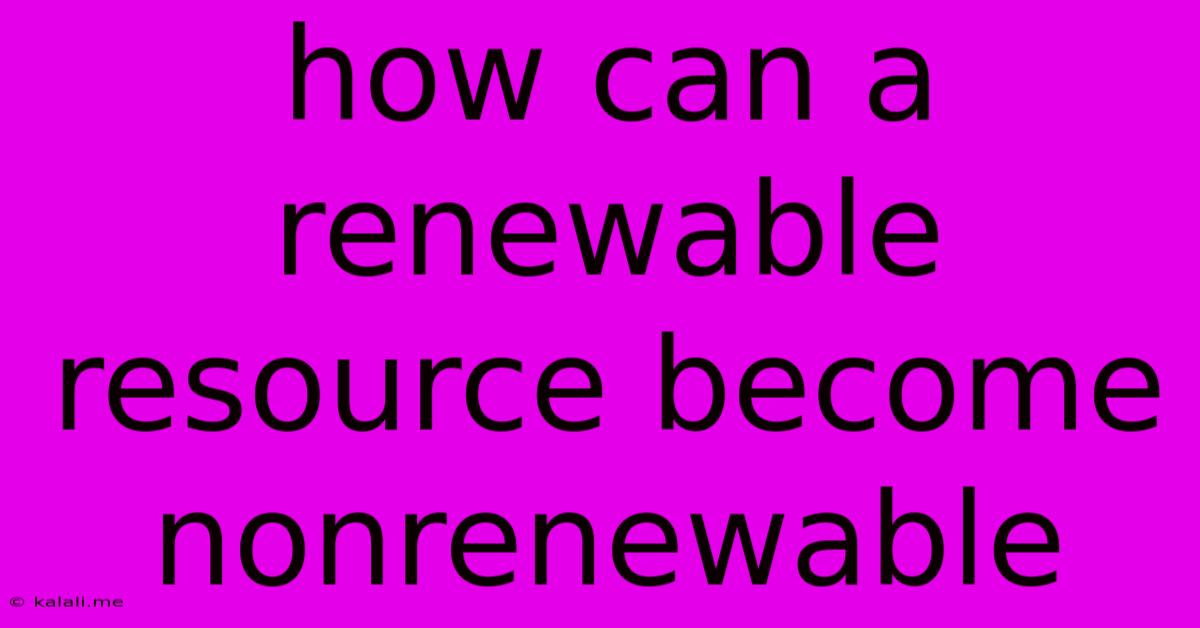How Can A Renewable Resource Become Nonrenewable
Kalali
May 09, 2025 · 3 min read

Table of Contents
How Can a Renewable Resource Become Nonrenewable? The Peril of Unsustainable Practices
Renewable resources, by definition, replenish naturally over a relatively short period. Think sunlight, wind, water, and biomass. However, the seemingly endless supply of these resources can become depleted if we don't manage them sustainably. This article delves into the factors that can transform a renewable resource into a non-renewable one, highlighting the crucial role of responsible resource management.
What are Renewable Resources? Before we explore the depletion, let's quickly recap. Renewable resources are naturally replenished at a rate comparable to, or faster than, the rate of consumption. This contrasts with non-renewable resources like fossil fuels, which take millions of years to form. The key here is the rate of replenishment versus consumption.
The Transition: How Renewable Resources Become Depleted
Several factors can push a renewable resource towards depletion, effectively rendering it non-renewable on a human timescale:
-
Overexploitation: This is perhaps the most significant factor. When the rate of consumption significantly exceeds the rate of natural replenishment, the resource begins to dwindle. Imagine overfishing: if we catch fish faster than they can reproduce, the fish population collapses, becoming effectively non-renewable unless drastic conservation measures are put in place. Similar scenarios exist for forests (deforestation), groundwater (over-extraction), and fertile topsoil (soil erosion).
-
Pollution and Degradation: Pollution can severely compromise the regenerative capacity of a renewable resource. Water pollution, for instance, can contaminate rivers and lakes, making them unsuitable for drinking or irrigation, effectively reducing the usable amount of this vital resource. Similarly, air pollution can damage vegetation and reduce the productivity of biomass resources.
-
Climate Change: The effects of climate change exacerbate the problem. Changes in rainfall patterns can lead to droughts and water scarcity, while rising sea levels can contaminate freshwater sources. Extreme weather events can also destroy forests and other renewable resources.
-
Inefficient Resource Management: Poor planning and inefficient technologies contribute to the unsustainable use of renewable resources. For example, inefficient irrigation techniques can lead to excessive water consumption, while wasteful agricultural practices can deplete fertile topsoil.
-
Lack of Conservation Efforts: Without proper conservation strategies and protective legislation, even naturally abundant renewable resources are vulnerable to depletion. This includes failing to protect habitats, ignoring sustainable harvesting practices, or lacking regulations on pollution.
Specific Examples of Renewable Resources Under Threat:
-
Groundwater: Over-extraction for agriculture and industry, coupled with pollution, is leading to depletion of groundwater aquifers in many parts of the world. Replenishment rates are often far slower than extraction rates.
-
Forests: Deforestation for agriculture, logging, and urbanization is reducing forest cover globally. This not only reduces the availability of timber but also impacts biodiversity and carbon sequestration capabilities.
-
Fisheries: Overfishing has led to the collapse of numerous fish stocks worldwide. Many commercially important fish populations are now significantly smaller than they were historically.
The Path to Sustainability:
Preventing renewable resources from becoming non-renewable requires a concerted global effort focused on:
-
Sustainable Consumption and Production: Reducing our overall consumption of resources and improving the efficiency of resource use are crucial.
-
Improved Technologies: Developing and implementing technologies that improve resource efficiency and reduce waste are essential.
-
Effective Policy and Regulation: Strong environmental regulations and effective enforcement are necessary to protect resources from overexploitation and pollution.
-
Public Awareness and Education: Raising public awareness about the importance of sustainable resource management is crucial for fostering behavioral changes.
In conclusion, while renewable resources possess the inherent capacity to regenerate, their sustainability depends entirely on human actions. By adopting sustainable practices, implementing robust policies, and fostering a culture of conservation, we can ensure that these vital resources remain available for generations to come. Ignoring this responsibility risks transforming our planet's valuable renewable resources into scarce, non-renewable commodities.
Latest Posts
Latest Posts
-
What Percentage Of 20 Is 1
May 10, 2025
-
The Coefficient In A Chemical Equation Represents
May 10, 2025
-
Highest Common Factor Of 45 And 60
May 10, 2025
-
Cual Oceano Es El Mas Grande
May 10, 2025
-
What Percentage Is 10 Out Of 12
May 10, 2025
Related Post
Thank you for visiting our website which covers about How Can A Renewable Resource Become Nonrenewable . We hope the information provided has been useful to you. Feel free to contact us if you have any questions or need further assistance. See you next time and don't miss to bookmark.